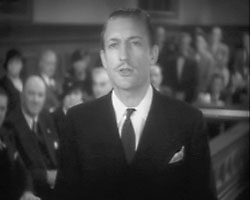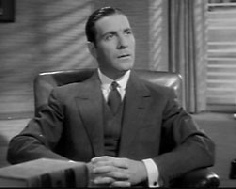Gardner was an attorney turned writer who began penning pulp detective stories in the early 1920s. In 1932 he created the Perry Mason character, a defense attorney and sleuth who proved his clients innocence by exposing the true culprit. Gardner’s adeptness for detective writing along with his knowledge of the law and courtroom procedures made these stories exceedingly popular. He would go on to publish 82 novels based on the Perry Mason character among his many other detective writings.
Warner Bros. acquired the rights to five of his stories and in 1934 made the first of the feature films based the character. Gardner did not like how his prized character was depicted, nor did he care for the actors that Warners chose to play Perry. He was particularly incensed that Perry was portrayed as a heavy drinking bon vivant instead of the hard edged attorney he was supposed to be. Gardner next sold the rights to Perry Mason for a radio drama which went on the air in 1943. Unlike the Warner’s deal, Gardner would write the scripts. But when CBS decided to run the show as a daytime serial, five days a week, Gardner relinquished his writing duties. Despite the shows popularity, Gardner again found himself at odds with producers about the portrayal of his characters.
When television came of age it was only a matter of time until the networks began making overtures about Perry Mason. CBS wanted to run Perry Mason much like the radio serial and make it a daytime soap opera. Gardner turned down several lucrative offers for the television rights because he was determined to do it his way. And his way meant having control over all aspects of any proposed series involving his character. Gardner may not of liked the treatment of his stories on the big screen and radio, but those deals along with his prodigious output of books allowed him the financial independence to deal with television on his terms. Instead of selling the rights to Perry Mason, Gardner formed his own production company. He would have the creative control he desired plus he would personally approve every script. Surprisingly, CBS agreed to all of Gardner’s terms and Perry Mason would be going to the small screen. Thomas Jackson, Gardner’s longtime literary agent, and Jackson’s wife, Gail Patrick, would be executive producers.
Selecting the cast would be the first order of business and like everything else about the future show, Gardner would have the final say. Numerous actors auditioned for the Mason part but it was Raymond Burr who the Jacksons chose with Gardner’s approval. There were those in Hollywood who didn’t think much of Burr’s selection. Nevertheless, Gardner stuck with his instincts and Burr demonstrated just how good and actor he was. In courtroom scenes he perfected the inflections and mannerisms that made his portrayal so convincing. Looking back, it’s hard to imagine any other actor playing Mason. That was evident when CBS revived the series in 1973 with Monte Markham as Perry. Viewers simply were not willing to accept anyone but Burr in the title role and the series disappeared after one season.
William Talman was selected for the role of D.A. Hamilton Burger, the prosecutor who would be Burr’s adversary in most of the episodes. Like Burr, Talman had spent most of his career playing villains in film noir. Although not as prolific as Burr, he did make his mark playing the vicious serial killer in The Hitch-
Veteran actor Ray Collins was chosen to play police lieutenant Tragg, William Hooper was picked for private investigator Paul Drake and Barbara Hale was selected to play Mason’s confidential secretary. Della Street.

By the mid 1950s, television had hit its stride. It had reached critical mass in terns of American households with TV sets and the available programing. Movie attendance had plummeted as more people stayed home for their entertainment. It was also the beginning of the end for film noir, at least as moviegoers had come to expect . Many of the early television crime dramas were simple adaptations of radio programs like Gangbusters and Dragnet. Martin Kane Private Eye and Crime Syndicated, aired in 1952. But like other shows of that time, there were limitations to what you could do in a live, 30 minute broadcast. Peter Gunn first aired in 1958 and had a very noirish style. Craig Stevens was credible as the tough P.I. dealing with a host of bad guys and most of the action took place at night in dark shadows. But with 30 minute episodes there was little time for character development and the low budget sets -
But in 1957 Perry Mason began airing on CBS and it would soon gain an ardent following of those who had come to appreciate the movies we now know as film noir. Several factors made this a unique show leading to it’s popularity. Perry Mason was the first hour long episodic crime drama with a regular cast. This allowed for greater story development than what viewers had been seeing in the compact half-
Collins was well known to viewers from his long film career but was an odd choice considering his age. Nevertheless, his dry wit and engaging banter with Burr enhanced the early seasons. Gardner, who never forgot Warners’ treatment of his stories would have no part of Burr having a glamorous secretary. That would be too Hollywood for his attorney who was all business. Like most of his decisions his instincts proved him right. In Barbara Hale he had an actress who was attractive but also had the credibility to portray someone who was capable of taking the copious shorthand of her boss.
With the cast in place a pilot episode, The Case of the Moth-
As with many aspects of success, timing is crucial and Gardner could not have been more fortuitous. When Perry Mason aired in the fall of 1957 film noir had run its course on the big screen. There was now a void of the stylistic black and white crime dramas that moviegoers had come to appreciate during the succeeding years. But in Perry Mason they were finding an alternative that in many ways embraced many of film noir’s essential elements. Yes, each episode involved a well established format having Burr taking on a client charged with murder and ending with him proving the client’s innocence by revealing the real killer. But it was the storey between these two counterpoints that resonated noir. The very elements that distinguish noir were there, and viewers were quick to recognize them.
The basic premise of the show, that of someone falsely accused, had long been a central theme of noir. In each storey were found the nefarious, double-


Warren William, above -
Ricardo Cortez, below -



Mandel Kramer was one of the more prolific actors of radio during the 1940s and 50s. He played Lt. Tragg on the Perry Mason radio series for many years.

Perry Mason might never have made prime time.
In a 1974 interview he talks about how Perry Mason might well have become a daytime television soap opera. But negotiations broke down with that network and Gardner struck a deal with CBS for Perry Mason to be a prime time drama.

The final element that gave the show its noir relevance was the cinematography. Like any long running series there would be multiple directors and cinematographers, each having their own style. Like film noirs themselves, the use of lighting and camera angels varies given the circumstances of each storey but no doubt influenced to a degree by the particular director and cinematographer. Frank Redman who was behind the camera for a number of episodes was an old hand at noir whose work went back to the early 1940s. Again, the higher standards and longer shooting schedules played a part, allowing for more creativity than had been the norm in episodic television. This was also a factor in the location shooting, which the show made appropriate use of. These all contributed to the shows noir ambiance. To the average viewer in the late 1950s, it was more like watching a good “B” flick on a double feature than a television show.
